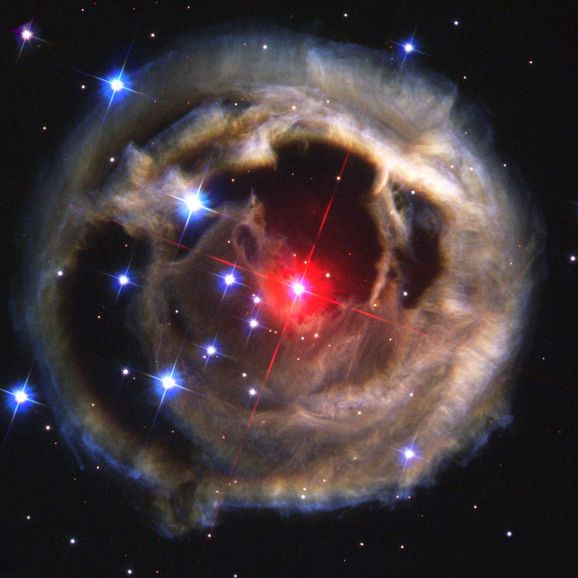
|
Credit & Copyright: H. Bond (STScI),
A. Henden (USNO Flagstaff),
Z. Levay (STScI),
et al.,
ESA,
NASA
Explanation:
Nominated
for most mysterious star in the Milky Way,
V838 Monocerotis briefly became one of the brightest stars
in our galaxy.
Its outburst
discovered
in January 2002,
observations have
indicated that V838
Mon somehow
transformed itself
over a period of months from a small under-luminous star a
little hotter than the Sun, to a highly-luminous,
cool supergiant star -- defying the conventional understanding
of erupting stars and stellar life cycles.
In this
spectacular image, one of a
series recorded last year by the Hubble Space Telescope, the dimmed
V838 Mon is surrounded by an "expanding" nebula.
But the nebula
is actually a series of
light
echoes from formerly unseen shells of dust up to light-years
in diameter.
Previously ejected, the intricate shells
progressively
reflect light as it reaches them from V838 Mon's outbursts.
Astronomers anticipate that light echoes from farther out
in the dust envelope will continue to be visible
until about 2010.
Some estimates now
place V838 Mon
about 20,000 light-years from planet Earth.
|
January February March April May June July August September October November December |
| |||||||||||||||||||||||||||||||||||||||||||||||||||||||
NASA Web Site Statements, Warnings, and Disclaimers
NASA Official: Jay Norris. Specific rights apply.
A service of: LHEA at NASA / GSFC
& Michigan Tech. U.
Based on Astronomy Picture
Of the Day
Publications with keywords: v838 mon - variable star - light echo
Publications with words: v838 mon - variable star - light echo
See also:
